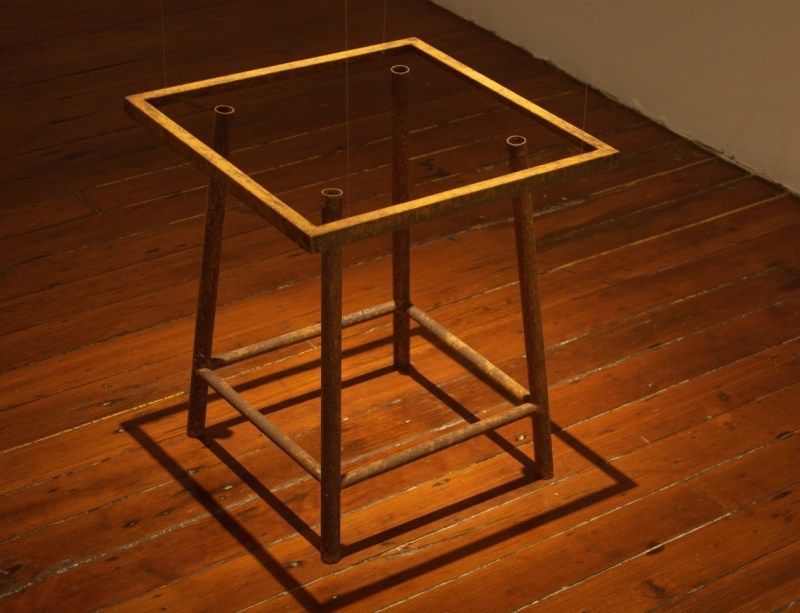
Link, one of the most arresting works on display at (In)Between, Alwar Balasubramaniam’s first show in two years, is a length of string that ends in a hook, suspended in mid-air. There are false walls and magnets at work here, but all you see is a hook reaching out, casting a shadow. Even if you aren’t an art connoisseur, it makes you stop, think, wonder. What is it that lies between those spaces? Is it a possibility unfulfilled? A frustrated desire, an ambition short of being actualized?
Trying to explain Bala’s (this is how he is known) art might seem simplistic. Yet the viewer’s perception is important to Bala: For him, that is what closes the circuit, completes the process of art. “Artworks are a by-product,” says Bala, 39, in his attempt to find answers to the questions that have haunted him since boyhood.
Growing up in Chennai, the son of a cab driver and a homemaker, Bala began winning prizes in drawing competitions early on. A place in the local Government College of Art materialized only after three attempts, but the philosophical strain that had made him wonder, as a 12-year-old, whether a bird skimming across the sky changed the sky forever, carried him through: He spent those years working in a plastics factory, learning the basics of silk-screen printing—the foundation for his knowledge of printmaking.
Bala graduated in 1995, but he had already learnt his most important lesson: You didn’t need a bachelor’s in fine arts (BFA) degree to be an artist. “Rembrandt didn’t have an art degree,” he points out quite seriously. That awareness gave him the freedom to teach himself whatever his work demands, from printmaking and sculpture to what he thinks will be his newest medium: video art.
A signature approach marrying the minimalistic with the conceptual makes Bala one of the most exciting artists working today. “He is a thinking artist,” says Dinesh Vazirani of Saffronart, which hosted one of the biggest auctions of the artist’s works last year. “Though his works appear simple, there are always layers. Simplicity and intellect combine very well in Bala’s art.”
The assessment finds resonance with the artist. “Art, for me, occupies the space between science and spirituality. The big question I am always trying to answer is apparently simple: Do we really see things? Consider the elements essential to our life: light, gravity, electricity, air…all of them are invisible, but that does not mean they aren’t there.”
In the 2007 exhibition (in)visible, the elements he mentions came together in an installation titled Energy Field. Using 22-carat cast gold, fibreglass, acrylic, wires and electric currents, Bala created a pedestal crowned by a golden apple, imagery that simultaneously channels Eve and Isaac Newton. It’s no secret, though, who excites him more. “I have always been intrigued by thinkers, people I call ‘seekers of truth’, people like Edison, Einstein, Newton. Their quests began with themselves, but what they learnt changed all of humanity.”
In his own way, that is a process the artist identifies with: Most of his works originate in a sense of egocentric playfulness, but his answers seek a relevance that rises above the purely personal. This makes for a “reductiveness”, the distillation of the artist, famously, into a pair of nostrils (Breath, 2007), and into 10 red marks in Orifice—a laser print of the artist’s sense organs, diminished to points to mark the meeting of inside and outside spaces—which is one of the 13 works that make up (In)Between.
This concern with the visible/invisible, trees and roots, is central to Bala’s work. In an untitled work, a mesh of ropes tries to capture the way rays of light enter a space through multiple openings, revealing a multitude of planes and possibilities that evade the non-seeing eye. A four-part installation called Kaayam (a Tamil word with multiple meanings) uses fibreglass cast in the artist’s own mould—a 3-hour process—and then distorts and crumples it to indicate the absence of something essential: the self.
If it’s difficult to pin down Bala in glib language and easily read signage, or even contextualize him prettily in the contemporary Indian art scenario, the artist wouldn’t have it any other way. “The continuum is indisputable, so why emphasize the link?” he asks. Especially when he makes his point with a suspended fishing hook anyway.
-Sumana Mukherjee